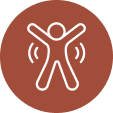Our Services
Dry Needling
Overview
Myofascial Trigger Points also known as muscle “knots” are hyperirritable, palpable nodule in the taut bands of our skeletal muscles. Sometimes direct compression on the muscle will cause local tenderness, local twitch response and referred pain.
Dry needling is an effective way to get rid of myofascial trigger points naturally. The insertion of thin filament needle helps to “release” the muscle knots and take the pressure off the nerves resulting in:
- Longer relief of muscular pain
- Reduced muscle spasms
- Improved range of motion
Benefits of Treatment

Lasting relief of muscle pain
Pressure on nerves is alleviated due to trigger points being released leading to pain relief

Reduced muscle spasms
Release of taut bands in trigger points and increased blood flow to the surrounding area reduces overall muscle spasm

Improved range of motion
Decreased tension in surrounding muscles help your neck and back move better
Suitable For
Sport Injuries
By addressing tightness and trigger points, dry needling can improve flexibility and range of motion, which is crucial for recovery and performance.
Runner’s knee
Dry needling can directly address tight muscles around the knee, such as the quadriceps, hamstrings, and IT band, which often contribute to pain and dysfunction.It also enhances the range of motion in the knee, making it easier for runners to move without pain.
Upper trapezius myofascial pain
By reducing tightness and improving muscle function, dry needling can enhance flexibility and range of motion in the neck and shoulders, making movement easier and less painful.
Low back pain
Many cases of low back pain involve tight muscles that develop trigger points. Dry needling directly targets these areas, helping to release tension and alleviate pain.
Treatment FAQ
Can I run the after doing dry needling?
After dry needling, it’s generally recommended to take it easy and avoid intense physical activities like running for at least 24 hours. Here’s why:
- Muscle Response: Dry needling can create a temporary increase in muscle soreness or tenderness in the area treated. Intense activities like running might exacerbate this discomfort or interfere with the muscle’s natural healing process.
- Post-Treatment Recovery: The body needs time to adjust after dry needling, as it stimulates the muscle tissue and encourages blood flow to the area. Giving your body time to recover can help maximize the benefits of the treatment.
- Possible Side Effects: Some people experience bruising, dizziness, or fatigue after dry needling, which may make running or intense exercise less comfortable.
However, light activities like walking or gentle stretching are typically okay. It’s always a good idea to check with your healthcare provider or the practitioner who performed the dry needling to get personalized advice, especially if you’re recovering from an injury or managing a specific condition.
Is dry needling painful?
Most people experience mild discomfort during dry needling, but it is typically well-tolerated. You may feel a “twitch response” when the needle hits a trigger point, which can be a quick, sharp sensation. Afterward, the muscle may feel sore, similar to the feeling after an intense workout, but this usually subsides within a few hours to a day.
Is Dry Needling the Same as Acupuncture?
No, dry needling is not the same as acupuncture. While both use needles, acupuncture is based on traditional Chinese medicine and aims to balance energy (qi) in the body. Dry needling, on the other hand, is rooted in Western medicine and targets muscle tissues to release trigger points, improve muscle function, and reduce pain.



